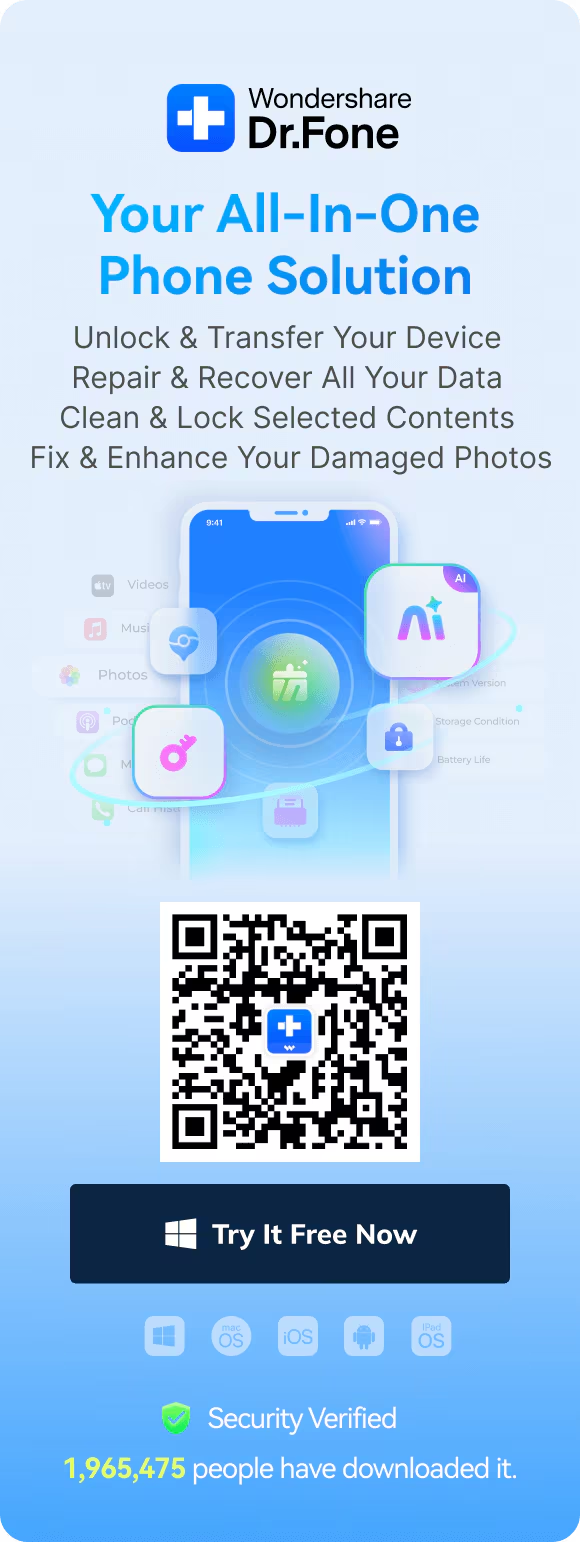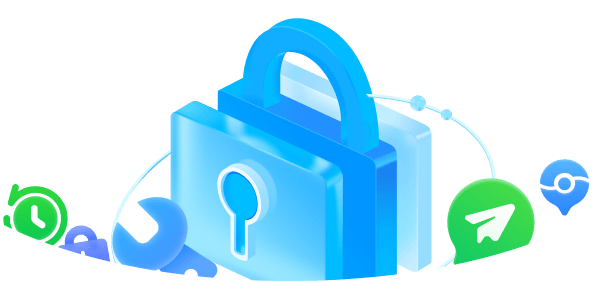Every action you take online leaves a trace, forming what is known as your digital footprint. If you've ever wondered, "What is my digital footprint?", it consists of both active footprints, which are the data you intentionally share, such as social media posts and online registrations, and passive footprints, which are collected without your direct input, like website tracking and cookies.
Managing your digital footprint is crucial for protecting your privacy, security, and reputation. Failing to do so can lead to identity theft, cyber threats, and unwanted exposure of personal information. Being mindful of what you share and regularly reviewing your online presence can help minimize risks.
To further enhance your security, Dr.Fone App - App Lock (iOS) provides an extra layer of protection by preventing unauthorized access to your apps. This tool helps safeguard sensitive data, ensuring that your personal information remains private and secure.
In this article
Part 1: How to Check Your Digital Footprint
Your digital footprint is everything about you online. It includes what you share, like social media posts and account sign-ups. It also includes data collected without your input. This includes website tracking and cookies. Knowing what is my digital footprint and how to check it is key for your online privacy and security.

Tools to Check Your Footprint: To check your digital footprint, use tools that can monitor your online presence. You can use search engines, social media, and privacy tools to see what information is online about you.
What to Look For: When checking your digital footprint, it's important to identify traces of personal data you may have left behind. This means looking for old social media accounts, forum posts, or old online profiles. These may still show sensitive information.
Steps to Analyze Results: Once you've reviewed your search results and online mentions, it's time to analyze what you've found. Start by identifying the information that needs updating or removal. Check your privacy settings on social media. Delete any accounts you don't use. If needed, ask to remove old content.
Part 2: What is a Digital Footprint and How to Erase or Remove It
Your digital footprint consists of all the information that is generated through your online activities. It can be divided into active and passive footprints. Understanding the differences between what is active digital footprint and passive digital footprints is essential for managing and erasing your online presence.
Active vs. Passive Footprints
An active digital footprint refers to the data you intentionally create through actions such as posting on social media, sending emails, making online purchases, or sharing content. This footprint is a result of deliberate actions you take online.
In contrast, a passive digital footprint is made up of data collected without your direct input. This includes information like browsing history, cookies, app usage, and location tracking. These passive footprints accumulate based on your online behavior and activities, even without you actively sharing data.
Erasing Active Footprints: Step-by-Step Guide
To know how to erase my digital footprint, follow these steps:
Step 1: Review Your Social Media Accounts
Go through each social media platform you use and review all your posts, comments, and interactions. Identify the content you want to remove.
Step 2: Delete Unwanted Posts and Content
Delete posts, photos, comments, and videos that you no longer want to be publicly visible. Most social platforms allow you to delete content directly or archive it for later.
Step 3: Deactivate or Delete Accounts
If you no longer use a social media account, consider deactivating or permanently deleting it. For instance, Facebook, Instagram, and Twitter have options for account deletion.
Step 4: Request Removal of Content on Third-Party Websites
If you find content on other websites or blogs that you want to remove (such as old comments, reviews, or forum posts), contact the website administrator to request removal.

Removing Passive Footprints: Step-by-Step Guide
To know how to remove digital footprint, follow these steps:
Step 1: Clear Your Browsing History
Open your web browser and clear your browsing history. On most browsers, you can go to the settings or preferences, select "Privacy" or "History," and then choose to clear the data.
Step 2: Delete Cookies and Cache
In the same privacy or history settings, select the option to delete cookies and cached files.
Step 3: Clear App Data
On iOS or Android devices, you can typically find the option to clear app data under Settings > Apps > [App Name] > Clear Data.
Step 4: Use Incognito or Private Browsing
To prevent future accumulation of passive footprints, use Incognito Mode or Private Browsing when browsing the internet.

Part 3: How to Reduce Your Digital Footprint
Reducing your digital footprint is crucial for maintaining privacy and security online. By taking proactive steps on how to delete my digital footprint, you can limit the amount of personal data shared and collected about you, giving you more control over your digital presence.
Adjust Privacy Settings
Adjusting privacy settings on social media and other platforms is a vital step to minimize your online presence. By managing who can see your data and limiting access, you can better control your digital footprint.
Step 1: Set social media profiles to private and restrict who can see your posts.
Step 2: Disable location tracking on social media apps.
Step 3: Remove or limit third-party app access to your data.
Step 4: Opt out of personalized ads in settings (e.g., Facebook, Google).

Smart Browsing Practices
Smart browsing practices help you avoid leaving unnecessary traces behind. By taking simple actions while browsing, you can protect your privacy and minimize data collection.
Step 1: Use Incognito Mode or Private Browsing to avoid saving history.
Step 2: Avoid logging into websites you don't trust or use regularly.
Step 3: Use ad blockers or disable third-party cookies to prevent tracking.
Step 4: Switch to privacy-focused search engines like DuckDuckGo.

Bonus Tips: Dr.Fone App: A Tool to Protect Your Digital Footprint
Protecting your digital footprint is vital for maintaining privacy and security online. Dr.Fone App - App Lock (iOS) provides a simple yet effective solution to secure your apps, keep sensitive information safe, and manage your digital presence with additional privacy features.
Key Features
Dr.Fone App Lock offers a range of features to enhance the security of your apps. You can lock and hide apps, use Face ID or PIN protection, enable Private Mode for extra security, and set location/time-based restrictions for a more tailored approach.
- Lock & Hide Apps: Keep your apps secure by locking them or hiding them from prying eyes.
- Face ID/PIN Protection: Protect apps with Face ID or a PIN for added security.
- Private Mode: Hide sensitive apps or data to ensure privacy.
- Location/Time-based Restrictions: Lock apps based on location or specific times to control access.
Dr.Fone App - App Lock (iOS)
Enhanced App Security: Lock/Hide Apps Based on Time and Location
- Lock apps to prevent accidental deletions or downloads.
- Hide apps from the home screen for enhanced privacy.
- Face ID/PIN code protection for secure access.
- Supports iOS 16 and above.
Step-by-Step Guide
Follow these simple steps to use Dr.Fone App Lock and secure your apps:
Step 1: Launch the Dr.Fone App Lock tool from the Dr.Fone suite.

Step 2: Create and organize app groups for easy management.

Step 3: Choose either Lock or Private Mode to protect your apps.

Step 4: Secure your apps with Face ID or PIN for additional protection.
Enable Face ID or a PIN to ensure that only you can access the locked apps.

Bonus Tip
Restrict Zone: Lock apps based on specific locations to ensure they remain secure wherever you go.
Restrict Time: Set specific times when apps are locked to prevent access outside designated hours.

Conclusion
In today's digital world, knowing how to erase internet footprint is essential for protecting your privacy and security. By following the steps to check, erase, and reduce your digital footprint, you can gain better control over your online presence. Utilizing tools like Dr.Fone App Lock further strengthens your efforts by securing your apps with features such as Face ID/PIN protection, Private Mode, and location/time-based restrictions.
We encourage you to incorporate Dr.Fone app into your routine for comprehensive app security and enhanced privacy. With this tool, you can ensure that your personal information remains safe and protected from unauthorized access, making it an essential part of managing your digital.
FAQ
-
Q: How can I protect my apps and sensitive information on my iPhone?
A: To protect your apps and sensitive information, it's essential to use a reliable security tool that locks your apps and keeps them private. A tool like Dr.Fone App Lock can provide additional layers of security with Face ID/PIN protection and Private Mode, ensuring only you can access your most important apps.
-
Q: What are some ways to manage my digital footprint and improve online privacy?
A: Managing your digital footprint involves taking control of your online presence by adjusting privacy settings, using private browsing modes, and securing your apps. Using an app like Dr.Fone App Lock helps you protect the apps where sensitive information is stored, adding another level of protection to your online security efforts.
-
Q: How can I ensure that my apps remain secure when I'm not around?
A: To keep your apps secure, consider using location and time-based restrictions. With tools like Dr.Fone App Lock, you can lock apps based on specific locations or times, ensuring they're protected even when you're not actively monitoring them.


























Julia Becker
staff Editor
Generally rated4.5(105participated)